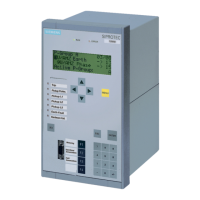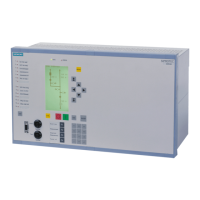allow asynchronous closing; the relay will then consider the circuit breaker closing time before determining
the correct instant for closing. Remember that closing under asynchronous system conditions is allowed only
if the circuit breaker closing time is set correctly (see above under “Preconditions”)! If you wish to permit
manual closure or closing via control command only under synchronous system conditions, set this address to
w/o T-CB close .
The permissible difference between the voltages is set in address 3531 MC maxVolt.Diff. The setting is
applied in Volts secondary. This value can be entered as a primary value when parameterising with a PC and
DIGSI. Depending on the VT connection these are phase-to-earth voltages or phase-to-phase voltages.
The permissible frequency difference between the voltages is set at address 3532 MC maxFreq.Diffthe
permissible phase angle difference at address 3533 MC maxAngleDiff.
The further release conditions for manual reclosing or reclosure via control command are set under addresses
3535 to 3539.
The following addresses mean:
3535 MC SYNCHR both measuring points U
sy1
and U
sy2
must be ener-
gized (Live Volt. Thr., address 3503); the
synchronism conditions are checked, i.e. MC
maxVolt.Diff (address 3531), MC maxFreq.Diff
(address 3532) and MC maxAngleDiff (address
3533). This parameter can only be altered in DIGSI at
Display Additional Settings;
3536 MC Usy1< Usy2> the measuring point U
sy1
must be de-energized Dead
Volt. Thr., address 3502), the measuring point
U
sy2
must be energized (Live Volt. Thr., address
3503) ;
3537 MC Usy1> Usy2< the measuring point U
sy1
must be energized (Live
Volt. Thr., address 3503), the measuring point
U
sy2
must be de-energized (Dead Volt. Thr.,
address 3502);
3538 MC Usy1< Usy2< both measuring points U
sy1
and U
sy2
must be de-ener-
gized ( Dead Volt. Thr., address 3502);
3539 MC OVERRIDE manual closing or closing via control command is
released without any check.
The five possible release conditions are independent of one another and can be combined.
NOTE
The closing functions of the device issue individual output indications for the corresponding close
command. Be sure that the output indications are assigned to the correct output relays.
No 2851
AR CLOSE Cmd.
for CLOSE via command of the automatic reclosure,
No 562
Man.Close Cmd
for manual CLOSE via binary input,
No. 2961
Sync.CloseCmd
for CLOSE via synchronism check (not required if synchronism check releases
the other CLOSE commands),
No 7329
CB1-TEST close
for CLOSE by circuit breaker test
additionally CLOSE command via control, e.g.
Brk Close
No 510
Relay CLOSE
general CLOSE command. It comprises all CLOSE commands described above.
Connections
The 7VK61 provides three voltage inputs for connection of the reference voltage U
sy1
and one voltage input
for the voltage U
sy2
to be synchronized (see example in Figure 2-23). If the connection is to all three phases,
the phase-to-earth voltages are always connected for U
sy1
whereas all connection types (phase-to-earth,
phase-to-phase) are allowed for the single-phase connection of U
sy1
. The latter holds also for the voltage U
sy2
Functions
2.4 Synchronism and voltage check (optional)
92 SIPROTEC 4, 7VK61, Manual
C53000-G1176-C159-5, Edition 05.2018

